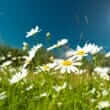Background
- Chamomile has been used medicinally for thousands of years and is widely used in Europe. It is a popular treatment for numerous ailments, including sleep disorders, anxiety, digestion/intestinal conditions, skin infections/inflammation (including eczema), wound healing, infantile colic, teething pains, and diaper rash. In the United States, chamomile is best known as an ingredient in herbal tea preparations advertised for mild sedating effects.
- German chamomile (Matricaria recutita) and Roman chamomile (Chamaemelum nobile) are the two major types of chamomile used for health conditions. They are believed to have similar effects on the body, although German chamomile may be slightly stronger. Most research has used German chamomile, which is more commonly used everywhere except for England, where Roman chamomile is more common.
- Although chamomile is widely used, there is not enough reliable research in humans to support its use for any condition. Despite its reputation as a gentle medicinal plant, there are many reports of allergic reactions in people after eating or coming into contact with chamomile preparations, including life-threatening anaphylaxis.
References
Natural Standard developed the above evidence-based information based on a thorough systematic review of the available scientific articles. For comprehensive information about alternative and complementary therapies on the professional level, go to . Selected references are listed below.
- Aertgeerts P, Albring M, Klaschka F, et al. [Comparative testing of Kamillosan cream and steroidal (0.25% hydrocortisone, 0.75% fluocortin butyl ester) and non-steroidal (5% bufexamac) dermatologic agents in maintenance therapy of eczematous diseases]. Z Hautkr 2-1-1985;60(3):270-277.
View Abstract - Benetti C, Manganelli F. [Clinical experiences in the pharmacological treatment of vaginitis with a camomile-extract vaginal douche]. Minerva Ginecol 1985;37(12):799-801.
View Abstract - de la Torre MF, Sanchez MI, Garcia Robaina JC, et al. Clinical cross-reactivity between Artemisia vulgaris and Matricaria chamomilla (chamomile). J Investig Allergol Clin Immunol 2001;11(2):118-122.
View Abstract - Glowania HJ, Raulin C, Swoboda M. [Effect of chamomile on wound healing--a clinical double-blind study]. Z Hautkr 9-1-1987;62(17):1262, 1267-1271.
View Abstract - Hormann H, Korting H. Evidence for the efficacy and safety of topical herbal drugs in dermatology: part 1: anti-inflammatory agents. Phytomedicine 1994;1(2):161-171.
- Ikram M. Medicinal plants as hypocholesterolemic agents. J Pak Med Assoc 1980;30(12):278-281.
View Abstract - Konig GM, Wright AD, Keller WJ, et al. Hypoglycaemic activity of an HMG-containing flavonoid glucoside, chamaemeloside, from Chamaemelum nobile. Planta Med 1998;64(7):612-614.
View Abstract - Kyokong O, Charuluxananan S, Muangmingsuk V, et al. Efficacy of chamomile-extract spray for prevention of post-operative sore throat. J Med Assoc Thai 2002;85 Suppl 1:S180-S185.
View Abstract - Maiche A, Grohn P, Maki-Hokkonen H. Effect of chamomile cream and almond ointment on acute radiation skin reaction. Acta Oncol 1991;30:395-397.
View Abstract - Maiche A, Maki-Kokkonen H, Grohn P. [Comparative trial of chamomile cream in radiotherapy]. Suomen Laakarilehti 1991;46(24):2206-2208.
- Patzelt-Wenczler R, Ponce-Pöschl E. Proof of efficacy of Kamillosan cream in atopic eczema. Eur J Med Res 2000;5:171-175.
View Abstract - Rycroft RJ. Recurrent facial dermatitis from chamomile tea. Contact Dermatitis 2003;48(4):229.
View Abstract - Saller R, Beschomer M, Hellenbrecht D, et al. Dose dependency of symptomatic relief of complaints by chamomile steam inhalation in patients with common cold. Eur J Pharmacol 1990;183:728-729.
- Weizman Z, Alkrinawi S, Goldfarb D, et al. Efficacy of herbal tea preparation in infantile colic. J Pediatr 1993;122(4):650-652.
View Abstract - Wilkinson S, Aldridge J, Salmon I, et al. An evaluation of aromatherapy massage in palliative care. Palliat Med 1999;13(5):409-417.
View Abstract







